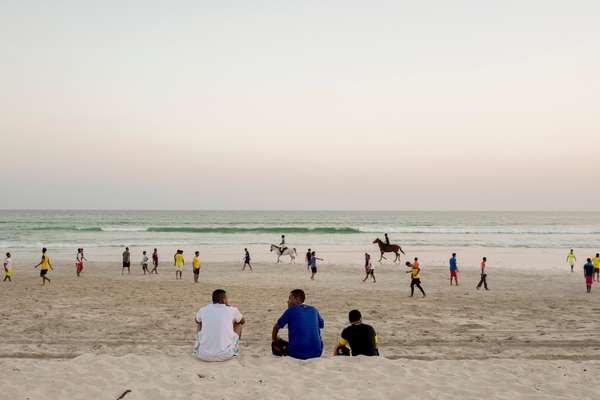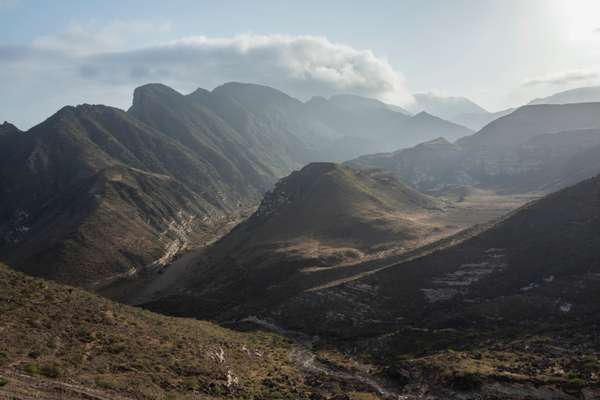Report / Salalah
Sunny outlook
During the monsoon season Oman’s second city turns into a lush oasis in the heart of the Arabian desert. It is ripe for discovery – and ready to give its Gulf neighbours some competition in the year ahead.
Mehmet Tunc brings the golf cart to a halt at the end of a concrete jetty. To our right, breakers flop onto a white sandy beach; to our left a fishing skiff chugs into a newly built marina. “You should see this place in August; you’d never find a room,” says Tunc, general manager of a hotel group in the south of Oman. “They come from all over the Middle East for... how do you call it?” He waggles his fingers in the air. “The drizzle.”
Salalah is an oddity on the Arabian Peninsula. Oman’s second city is in the mountainous Dhofar region just a few hours from the Yemen border. It sits in a sweet spot of the tropics, meaning that at the height of summer – when the rest of the region reaches boiling point – temperatures become comfortable and a fine monsoon rain called the khareef blows in off the Arabian Sea.
What happens next is hard to believe. As the dusty earth blooms with life, bemused camels graze on rolling meadows and cracked riverbeds rush with rain water. For years Salalah’s small clutch of hotels filled each summer with Arab travellers seeking cooler climes but now new hotels are launching up and down this stretch of coastline to take advantage of the tourism and a projected boom in trade.
Some 500,000 people visited Dhofar during the last monsoon, most coming from around the Gulf. There’s money to be made here and that’s attracting high-end hotel brands such as Anantara, whose target market is apparent on its opening night as couples from Kuwait, Saudi Arabia and Qatar saunter around the grounds. “Privacy is paramount for us,” says the duty manager as he whisks us past well-shielded cabanas.



By September the rains stop and the grass yellows again. The non-Gulf tourists who typically come for the sunnier months are a cadre of dedicated Europeans and a curious contingent of Mormons who interpret a passage from their holy book to mean that Salalah is a bit like paradise. Today Tunc shares the sentiment. “Until April we’re at 100 per cent occupancy,” says the Turkish hotelier in the lobby of his Fanar Hotel, where flags of the Czech Republic, Poland and Germany flutter in the forecourt. Tunc came here after running properties in saturated tourist towns in Turkey’s Antalya and Sharm El Sheikh in Egypt. “Here,” he says, “it’s virgin land.”
Hoteliers talk about bringing the “right” travellers to Salalah and the sultanate has long kept tourism on a tight leash. New developments are heavily regulated and few want to see another Sharm built here, however lucrative that might be. This has spared the country from the cowboy developers and less sagacious skyscrapers that sprang up in places such as Dubai but it also kept Oman’s economy more beholden to oil.
The country is now at a crossroads. The crash in oil prices is accelerating its diversification plan and in September the sultanate held talks that brought business and government together to hash out what needs to be done. Tourism, logistics and infrastructure are the linchpin sectors and, in Salalah, there’s a palpable gold rush taking place as the potential of its unblemished beaches, strategic location and weird weather becomes clear.
“We build towns,” says Ahmed Dabbous, ceo of Muriya, a private developer that as part of a public-private partnership has poured €374m into Salalah’s coastline and built a string of hotels, private residences and a new marina. Muriya’s projects, he explains in the company’s offices in the capital Muscat, emphasise creating opportunities for entrepreneurs and retailers. Dabbous predicts that by 2020 the firm will have built 1,000 new rooms across Salalah.
A grand steel-and-glass airport opened last year. Charters are landing from Köln-Bonn and the Turkish-run duty free is open for business. But right now it’s quiet enough to hear the crickets chirping. “It looks big today because there aren’t many flights,” says François Bouteiller, ceo of Salam Air, a new low-cost airline that makes its maiden Salalah-Muscat flight in 2017. About eight international flights a week land in Salalah but Bouteiller foresees a regional routemap out of Salalah in the not-too-distant future. “The reasoning behind Salam Air is to make it affordable for companies to get around Oman and do business.”
Outside there are brand-new roads flanked by curtseying coconut palms. The streets are quiet now but this is infrastructure built to cope with a busy future. Head north and it’s a long drive to Muscat and soon a direct route to Saudi Arabia; turn west and the highway leads to Yemen. And then there’s Iran. Omanis make no secret of the warmth between the two countries – Sultan Qaboos hosted talks between the US and Iran ahead of the nuclear deal and old alliances aren’t easily forgotten. Oman hopes to be first in line if and when trade barriers come down. “Iran needs five to 10 years to build its infrastructure,” says Ahmed Ali Akaak, deputy ceo of the Port of Salalah, which signed up in 2016 to help Iran expand its shipping facilities. “As soon as the sanctions lift, we will be the gateway for Iran to access the global market.” The port’s strategic location means it takes just two weeks to sail to New York from here.
Oman’s workforce is also a plus. Locals are employed in the tourism sector but there’s also a growing tide of graduates on the hunt for high-skilled work and the government is keen to encourage investment that gets more people into the private sector. Incoming businesses that can train and use the local workforce will find doors open. “We’re spending money on infrastructure and want investors to come in because we need jobs for our young people,” says Mohammed bin Abu Bhacker Al Ghassani, the representative for Salalah at the Majlis Al Shura, Oman’s elected consultative council.
The Majlis Al Shura reflects some of the shifts taking place in Oman. It was founded in 1991 to foster more engagement among Omanis; in the aftermath of the 2011 Arab Spring Sultan Qaboos endowed the council with greater legislative powers. At the same time reform is happening nationally: some overdue labour rights, being tougher on corruption and now a real bid to cut red tape for business. Salalah will be one of the first places to reap the benefits, although not much moves quickly here. “We may be slow at getting things done,” says Al Ghassani, “but it’s in our nature.”
Reasons to go:
- Surf: Oman’s coast has some of the more consistent surf in the Middle East; Aseelah, four hours’ drive from Muscat, is a firm favourite.
- Pipe performance: See the Royal Oman Police Camel Pipe Band at the Royal Opera House in Muscat. Their uniforms were cut in Savile Row upon the request of Sultan Qaboos.
- Honey: Buy honey from Jifr in the Al Hajar mountains. It’s made by keeping bees in the hollowed-out trunks of palms.
- Resorts: Oman has some of the best retreats, from the Chedi in Muscat to the village-scale Six Senses resort in Zighy Bay.
- Nature: Explore the formidable fjords in the Musandam, a mountainous exclave of Oman.


